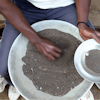Overview of Similar Applications
Processing individual ingredients toward a more useful end is as old as humankind. Witness the magnificent cave paintings of our ancestors as an expression of their daily lives that became possible by mixing common ingredients to manufacture pigments. Of course, manufacturing efficiency has very little influence when much of your day is given to collecting nutrients and avoiding predators, so providing a pigment batch at irregular intervals is sufficient to the purpose.
Fast forward to our current century where substantial process manufacturing is still being accomplished one batch at a time. Pharmaceutical manufacturing in particular is biased toward batch operations for a variety of reasons. Some of the reasons are due to prior regulatory environments that favored batch validation and general stasis of the manufacturing situation. One may argue that the unique relationship pharmaceutical manufacturing has to human health abets the batch inertia. However, the regulatory environment has significantly changed in the prior decade with renewed emphasis on understanding the process very deeply (1,2). In addition, other industries have been involved with continuous manufacturing and they enjoy high success rates.
In these industries, there are examples of formulation analogues to solid oral dosage formulations that utilize continuous techniques to manufacture their products. One application involves cross-linking polyethylene (PE) pellets with organic peroxides. The organic peroxide may be thought of as the active ingredient in liquid form and thereby requires fine control of its addition to maintain the functionality of the extruded wire coating. The PE pellets are of a similar size to a pharmaceutical unit dosage and each pellet must have the proper amount of peroxide applied. The components exit as effluent, in a real time release scenario to an extruder. Inconsistencies in content uniformity may be reflected in poor extruder performance or more importantly in a coating failure in the field. Considering that some of these wire coatings are undersea applications, one can see the impact of such a failure.
A second application with analogies to pharmaceutical manufacturing, particularly with regard to formulation constituents, is processing detergents. These formulations contain builders that are analogous to pharmaceutical diluents, cleaning agents analogous to the active pharmaceutical ingredient (API) and flow aids analogous to silicon dioxide. They also contain a striking analogue to the lubrication step. The formulation contains a chlorinated component that will degrade under the aggressive agitation necessary to mix the main formulation constituents and thus requires a secondary, gentle tumble mixing step. This, of course, mimics the requirements of lubrication addition in solid oral dosage formulations.
Each of the above operations is processed at several thousand kilograms per hour (kg/hr) with good content uniformity and high yields.
Amenable Processing Operations
Many manufacturing applications are transferable from batch to continuous processing. The continuous processes often maintain similar abilities on the ultimate result because the basic unit operation remains the same. An influential criterion for choosing between batch and continuous processing is the throughput requirement. Continuous operations generate substantial amounts of product and several tons per hour are common rates. These high rates are inappropriate for solid oral dosage manufacturing but vendors now offer pharmaceutical-ready, low throughput devices that have much lower throughputs; often at 5 kg/hr and less.
A non-exhaustive list of operations that transfer well to continuous may include tumble powder blending, high intensity powder mixing, wet granulation of various varieties, drying and hot melt extrusion. Because of its ubiquity in general process schemes, the continuous mixing application will be dealt with in some detail in the succeeding paragraphs that detail the positive and negative aspects of continuous processing. To make the contrast more effective, we will assume a continuous operation delivering 100 kg/hr (figure 1 above) versus a singular batch operation utilizing a 1500 liter vessel (figure 2 below). In both examples, an 8 hour production run will yield about 800 kg of drug product.
Positive Aspects of Continuous Processing
It is difficult to overstate the extensive advantages of continuous processing.
These systems are built to operate on a 24 hour per day and 7 day per week work cycle resulting in impressive utilization efficiencies. By contrast, the batch unit operation encompasses only a small portion of the production day. A typical mixing time for a 1500 liter vessel would be on the order of about 30 minutes. Substantial additional time would be encountered in ancillary duties including staging the raw materials, loading the materials, sampling the completed batch, discharging the batch and cleaning the vessel in preparation for a subsequent process run.
Cleaning downtime may be minimized with continuous processing as these systems are offered with the ability for a quick changeover of the vessel and agitator bar. A single drive station is capable of accepting several sizes of the continuous vessels, allowing wide process ranges that are typically between 5 and 200 kg/hr. The attachment point to the drive station is similar to the familiar multi-vessel processing stations seen with batch offerings. Consequently, the vessel and agitator bar may be quickly removed (< 15 minutes) and replaced by a fresh system as the previous system is sent off for cleaning.
Analytical processing is simplified within continuous applications. When assessing batch uniformity, a small group of samples is collected to represent the entire batch. This sampling, often done with a sampling thief, has its own inherent drawbacks that include drawing down surface material to the sample site as the thief enters the powder bed, preferential filling of the thief cavity by better-flowing formulation constituents and entrapment of smaller particles in the annular space of the thief’s tube within a tube design. The analysis requires high value employees for evaluation and the samples themselves may languish for several weeks in the analytical queue. Continuous applications are ideal for on-line analysis with technologies like near infrared spectroscopy (NIR) that provide the analytical assessment very quickly, do not require sample preparation and are suitable to remote sampling via fiber optic probes. There is an initial method development phase where NIR, a secondary technique, must be established versus a primary method, but once this is accomplished the continuous analysis may be monitored within software-developed, standard operating procedures that are quite easily adapted to the operator level.
The other advantage of this type of analysis is the reduction of in-process inventory, as immediate release is now feasible. Perhaps even more important is the pervasiveness of sampling available. A large portion of the effluent stream is monitored continuously and a much broader profile of the system is available. Consequently any uniformity issues can be reconciled quickly. The actual at-risk mass is very small and is generally a kilogram or less as represented in the hold-up volume of the mixer. Novel statistical techniques have been proposed to deal with the larger sample size (3).
There are a few other more esoteric advantages within continuous applications. Scale-up becomes much less complex. With batch applications, similarity criteria (generally geometric, kinematic and dynamic) are established in the pilot scale vessel. These criteria are promoted to the larger vessel, with varying degrees of success, as the scale-up factor. Continuous scale-up is time related and based on a common period of residence among the vessel sizes. A retention time of 180 seconds in a 5 kilogram per hour operation can easily be replicated to a 100 kilogram per hour operation by increasing the hold-up volume, which, in effect, is merely placing a larger vessel on the common drive station.
Another advantage, often not readily apparent, is the simplicity within which continuous fits into efficient experimental design, especially when real time analysis with NIR has already been established versus a primary method. A factorial sequence with replicates that evaluates machine factors such as agitator bar tip speed, vessel tip speed and vessel slope with respect to a critical quality attribute such as mix uniformity, thereby proving a proven acceptable range, may be accomplished in one day of testing. Contrast that with the time that would be necessary to a complete a similar factorial sequence in a small batch vessel as thief samples are drawn for analysis by the laboratory.
Finally, the space utilization difference of batch versus continuous is another profound advantage. A general arrangement for the continuous scenario of delivering 100 kg/hr will fit on a table top while the batch scenario of utilizing a single 1500 liter batch requires a large processing suite.
Drawbacks to Continuous Processing
There are disadvantages to continuous processing but many of them may be reconciled through judicious planning. For example, if the continuous process is not well-characterized and controlled in the experimental stage, it is possible to have substantial material manufactured before one is aware of any problem. The batch unit may also contain significant material but the only at-risk portion is what is contained in the blender and the possibility exists to re-work this material.
Manufacturing complex formulations with multiple ingredients may also be a limiting factor for continuous processing. It is fairly easy to stage 2 or 3 feeders at the input end of the continuous process but if the formulation contains 6 or more ingredients, staging this many feeders may be impossible or economically prohibitive considering the cost of additional feeders. A second issue related to the complexity of the formulation is the addition of the lubricant. The main formulation components with a low dosage API require a high speed mixing environment to achieve uniformity. However, the functionality of the lubricant would degrade under such an environment and the lubricant must be blended in a gentle tumble mixing situation. In a batch process, it is simple to utilize the agitator bar for the high energy step, then add the lubricant and continue the process without the agitator and achieve a simple tumble blend. In a continuous process, this may involve two mixers in sequence; one for the high speed portion and the second for lubricant addition. There are continuous mixing technologies that overcome the problem by dividing a single continuous mixer into sections that are capable of high speed mixing followed by a gentle tumble action.
A final issue is related to environmental control. In the batch unit, dust-free transfer of the raw materials and subsequent dust-free transfer of the finished formulation to a receiving container are well-established. The continuous may also achieve an environmentally clean transfer but with the multiplicity of feeders and the outflow transfer to a tablet press, environmental control becomes more problematic and sophisticated.
Understanding First Principles and the Grand Algorithm
The ultimate advantage of continuous processing is the potential to build into a grand algorithm for efficient process control. Experimental design can readily establish proven acceptable ranges for critical process inputs like agitator bar tip speed, vessel tip speed and agitator bar design as these inputs relate to critical quality attributes like blend uniformity and particle size. Available technology can constantly monitor the critical quality attributes in near real time and then engender adjustments of the critical process inputs according to the process algorithm developed in the experimental phase. Sophisticated feedback loops are possible within many common Process Analytical Technology software packages. (4,5)
References
1. Pharmaceutical cGMPs for the 21st Century-A Risk-Based Approach: Second Progress Report and Implementation Plan, Department of Health and Human Services, US Food and Drug Administration, September, 2004.
2. Guidance for Industry PAT- A Framework for Innovative Pharmaceutical Development, Manufacturing and Quality Assurance. US Department of Health and Human Services, US Food and Drug Administration, Center for Drug Evaluation and Research, Center for Veterinary Medicine, Office of Regulatory Affairs, Pharmaceutical cGMPs, September, 2004.
3. “Continuous Verification-Providing an Alternative Approach to Process Validation,” R. Kettlewell et al. Pharmaceutical Engineering, Jan/Feb 2011.
4. “Process Analytical Technology(PAT)-PAT and Batch Recipe Execution,” Emerson Process Management White Paper, Life Sciences, May 2010.
5. “SIPAT The Software Heart of PAT,” Siemens Product Brochure, Siemens NV, Belgium, November, 2007.






















